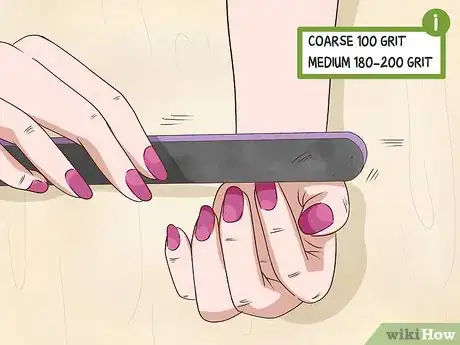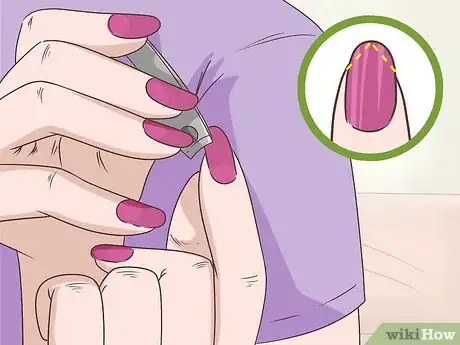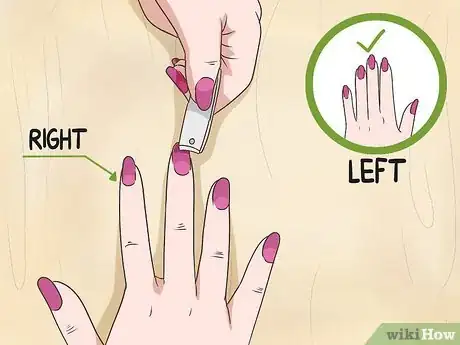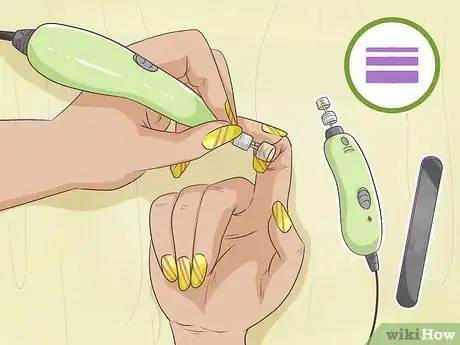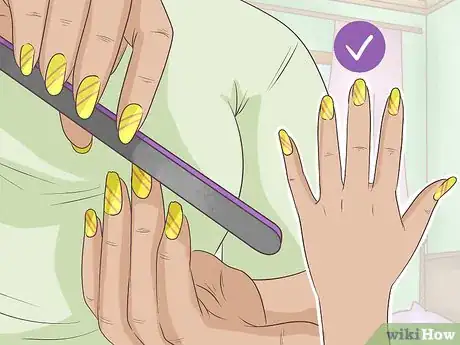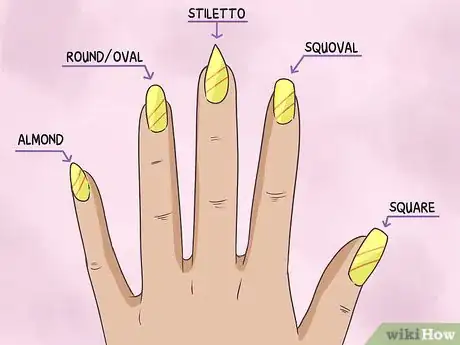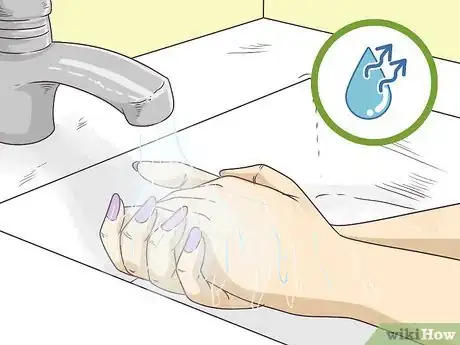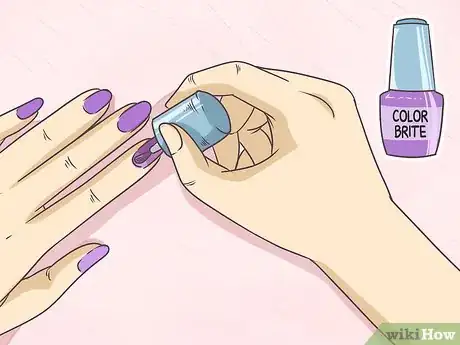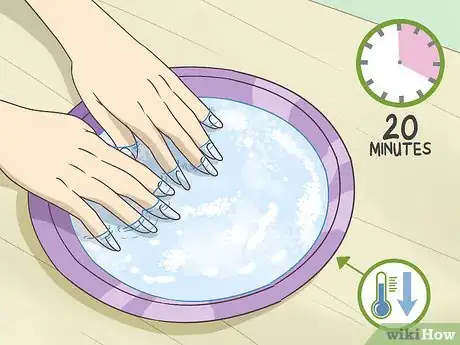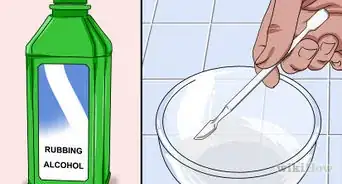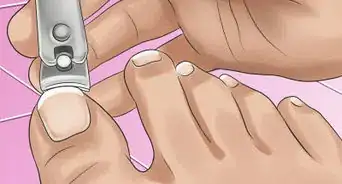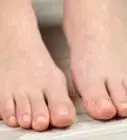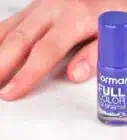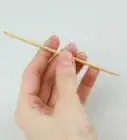This article was co-authored by Lindsay Yoshitomi. Lindsay Yoshitomi is the nail artist behind the blog, Lacquered Lawyer. She was featured as one of Nail It! magazine’s “Bloggers You Should Know,” and has been on the cover of Nail Art Gallery Magazine. She has been practicing nail art for over 15 years.
There are 17 references cited in this article, which can be found at the bottom of the page.
This article has been viewed 165,817 times.
Acrylic nails can be a great way to add length and shape to your manicure, but can become frustrating if they’re too long. To save some time and money, you can cut your acrylic nails at home in between salon visits. Just be sure to follow a few easy guidelines to avoid damaging or shattering the acrylic.
Steps
Nail Trimming
-
1Determine how long you'd like your nails to be. Before you start cutting, think about how much you want to take off. If you don’t want to reduce the length very much, you can skip using a nail clipper and just file it down instead.[1]
- Not sure exactly how short you want to go? Start with a small cut. You can always cut or file your nails shorter later on.[2]
- If you'd rather just use a file, start filing from the sides of the nail towards the center. Acrylics are fairly tough, so use a coarse (around 100 grit) or medium (180-220 grit) file and opt for emery board or metal file to shorten your nails more quickly.[3]
-
2Position the clippers on the outside of the nail and cut towards the middle. Use the edge of the clipper on the edge of your nail to make a small cut towards the center. Try to angle the clippers diagonally upwards towards the center of the nail, so there is a small point at the center.[4]Advertisement
-
3Cut towards the middle of the acrylic on the other side. Use the clippers to mirror the cut on the other side of the nail, meeting at a point the center of the nail. This two-step process will help to keep your acrylic nails from breaking or shattering.[7]
- The center of the acrylic nail is a stress point that, if cut directly, could cause the whole piece to split. By approaching it from both sides, you minimize the chance of ruining the nail.
-
4Remove the cut tip by pulling with your fingers. The cut acrylic tip likely won’t fall off on its own, despite being detached. Try gently pulling or bending the cut portion back to remove it, but stop and go to a nail technician if you feel the nail starting to crack vertically.[8]
- You may need to use the nail clippers to re-cut portions of the acrylic if you find it’s still attached in some places.
Acrylic Adjustments
-
1Thin out your nails using a nail file or motorized nail grinder. After you cut your acrylic nails, they will likely be thicker than you want. You can thin them out using a motorized nail grinder if you have one, or simply use a regular nail file for similar results.[9]
- Thin with the grinder or file on top of the acrylic nail rather than underneath it.
-
2Use a nail file to smooth out jagged edges. As you did with the nail clippers, start filing from the sides of the nail towards the center. Acrylics are fairly tough so feel free to move quickly at first. You’ll need to slow down when you focus on shaping.[10]
- Acrylic nails are much thicker than real nails, so filing them down will take longer. Be patient and don’t rush, otherwise you’ll risk uneven or too-short results.[11]
- Opt for an emery board or metal file rather than glass options. Their rougher textures will make working on acrylics much faster.[12]
- Use a coarse file (around 100 grit) to reduce the length of acrylic nails quickly or try a medium file (180-220 grit) board for more control.[13]
-
3File the tips of your acrylic nails into your desired shape. Switch to a medium (180-220 grit) or fine (400-600 grit) file to shape the tips of your nails into the desired look.[14] Three of the most common nail shapes include square, oval, and squoval (a mix between oval and square), but you can also try a classic round, trendy stiletto, or interesting almond shape.[15]
- To figure out what nail shape will look best on you, try looking at the shape of your cuticles. If they are rounded or curved, a round nail is a good bet. If they’re more angled, a square shape would probably look nice.[16]
Finishing Touches
-
1Rinse and dry your hands to remove acrylic dust. Filing down acrylic can leave a fine dust on your fingers. Use warm water to rinse it off before painting your nails so you don’t end up with a bumpy manicure.
- Make sure your nails are fully dry in order to prevent moisture from getting trapped under the polish and causing it to lift or chip.[17]
-
2Paint 1 coat of nail polish in a color that matches your acrylics. Apply 1 even coat across the nail and along the outer edge to seal and add strength to your nails. This will also help cover up small imperfections caused by trimming or shaping.[18]
- If you don’t have a color that matches your acrylics, try a clear top coat for a similarly finished effect.
- To make your nails look longer, extend the nail polish all the way to the cuticle. Use a cotton swab to clean up any polish that gets on your skin.[19]
-
3Let the polish dry fully to avoid smudges and dents. Give your nails 20 minutes to an hour to dry completely and avoid ruining your freshly painted manicure. Polish more than 6 months old can take even longer to fully dry, so try to use newer bottles for quicker dry times.[20]
- In a hurry? To dry painted nails faster, try dipping them in a bath of ice water, blasting them with a hair dryer on the cool setting, or using a store-bought drying liquid.
Warnings
- If, while cutting your acrylic nails, you feel them start to split vertically, stop and visit a nail technician for a repair. Otherwise, you risk ruining your manicure and potentially damaging your natural nail.[23]⧼thumbs_response⧽
- Avoid putting unnecessary stress on your acrylic nails so they don't break.[24]⧼thumbs_response⧽
Things You’ll Need
- Nail or toenail clippers
- Nail file or emery board
- Matching nail polish or clear top coat
References
- ↑ https://youtu.be/4J4XitVvaEQ?t=51
- ↑ https://youtu.be/h3FW_gJAHUw?t=57
- ↑ https://www.nailsmag.com/article/108747/the-ultimate-file-guide
- ↑ https://youtu.be/h3FW_gJAHUw?t=33
- ↑ https://youtu.be/h3FW_gJAHUw?t=33
- ↑ https://youtu.be/90esr72jjgA?t=169
- ↑ https://www.thriftyfun.com/Trimming-and-Upkeep-of-Acrylic-Nails-1.html
- ↑ https://youtu.be/h3FW_gJAHUw?t=73
- ↑ https://youtu.be/4J4XitVvaEQ?t=233
- ↑ https://youtu.be/Qg--FouXYDQ?t=147
- ↑ https://youtu.be/h3FW_gJAHUw?t=132
- ↑ https://www.more.com/beauty/nails/nail-care/how-shape-your-nails
- ↑ https://www.nailsmag.com/article/108747/the-ultimate-file-guide
- ↑ https://www.nailsmag.com/article/108747/the-ultimate-file-guide
- ↑ https://www.more.com/beauty/nails/nail-care/how-shape-your-nails
- ↑ https://www.more.com/beauty/nails/nail-care/how-shape-your-nails
- ↑ https://www.allure.com/story/waterless-manicure-trend
- ↑ https://youtu.be/h3FW_gJAHUw?t=164
- ↑ https://youtu.be/h3FW_gJAHUw?t=164
- ↑ https://www.byrdie.com/how-long-does-it-take-nail-polish-to-dry
- ↑ https://www.bustle.com/articles/131238-can-you-cut-your-nails-with-a-gel-manicure-not-ruin-them-photos
- ↑ Lindsay Yoshitomi. Nail Artist. Expert Interview. 12 July 2019.
- ↑ https://www.nailsmag.com/article/92707/filling-in-the-cracks
- ↑ Lindsay Yoshitomi. Nail Artist. Expert Interview. 12 July 2019.
